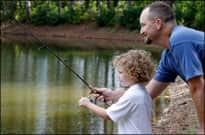Newcomers to Fishing Hits All-time High
Arkansas Game and Fish Commission 09.05.13

Showing a resurgence in one of America’s favorite pastimes, the number of Americans who go fishing is up, with more than 47 million people participating in 2012. Adding to the 42.5 million who are current or occasional anglers, more than 4.5 million first-timers tried fishing in 2012, a significant increase from 2011 and the highest number of new participants ever recorded.
The 2013 Special Report on Fishing and Boating just released by the Recreational Boating and Fishing Foundation and The Outdoor Foundation also shows significant increases in fishing participation among women and children.
“We’re extremely pleased to see the number of first-time anglers and participation overall continue to rise,” said RBFF President and CEO Frank Peterson. “Working closely with our industry and state agency partners, our collective effort is yielding well deserved results. Increased participation, in both fishing and boating, leads to increased license sales, and boat registrations, key sources for funding state fish and wildlife conservation programs.”
“Fishing and boating are among the most important ‘gateway’ activities that often lead people, especially youth, to pursue other recreation experiences,” said Christine Fanning, Executive Director of the Outdoor Foundation. “We’re thrilled to partner, once again, with the Recreational Boating and Fishing Foundation on this important research project.”
Arkansas Game and Fish Commission Fisheries Chief Mark Oliver said fishing is especially appealing because it allows anglers time to spend with friends and family. “It’s something people can do to escape the daily stress of life. It is one of those rare activities where almost any beginner can pick up a cane pole or rod and reel and be fishing within just a few minutes. I can’t think of anything more relaxing,” Oliver said.
The fifth annual report provides detailed information on boating and fishing participation by gender, age, ethnicity, income, education and geography.
KEY FINDINGS
Fishing Participation
- In 2012, 47 million Americans participated in fishing (an increase from 46.2 million in 2011).
- While 9.4 million people stopped fishing, 10.2 million new or returning anglers participated in the sport, netting a gain of more than 870,000.
- Americans made one billion fishing outings in 2012, averaging 21.3 fishing days per person.
- Forty-one percent of first-time fishing participants were female, bringing the total of female anglers to 34.4 percent.
- Adults 18 and older with children in their households participate in fishing at higher levels than adults without children.
- Fly fishing has the highest rate of first-time participants with 20.5 percent.
Hispanic American Fishing Participation
- In 2012, 2.8 million Hispanic Americans participated in fishing in 2012 – a slight decrease from 3.1 million in 2011.
- Freshwater fishing is the most popular type of fishing among Hispanic Americans.
- Hispanic Americans fish the most often out of all ethnicities, averaging 21.6 fishing days per year.
Youth Fishing Participation
- Fishing participation for children peaks between the ages of six and 12, then decrease during the adolescent years from 13 to17.
- In 2012, 81.8 percent of youth anglers ages six to 12 are introduced to outdoor activities by their parents.
- Participation declines among females ages 13 to 17 more sharply than among males of the same age.
- More than 45 percent of youth fishing participants ages six to 17 also participate in boating.
The full study is available online at TakeMeFishing.org/Corporate.

